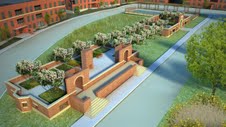Tosa historic buildings proposed as public open space
A pair of historic buildings in Wauwatosa would be converted into public open space, featuring portions of their red brick walls and newly planted trees, as part of Mandel Group Inc.'s plan to develop nearly 200 apartments near the site.
The buildings are on the County Grounds, east of Highway 45 and south of Swan Blvd., and are among four buildings designed by noted architect Alexander Eschweiler.One of the other Eschweiler buildings would be demolished.
The largest of the Eschweiler buildings would be converted into a fitness room, community rooms and other amenities for the proposed apartments, as well as offices for nonprofit groups and a conference center for use by the public.
The revised proposal will be reviewed at Wednesday night's meeting of the city Historic Preservation Commission.
The commission isn't expected to make a decision tonight on whether to approve the plans, said Barry Mandel, Mandel Group chairman. Commission approval is needed for demolition and other exterior renovations of buildings designated as historic, but commission's rulings can be appealed to the Common Council.
Mandel Group executives in May told commission members that they had originally hoped to to restore all of the Eschweiler buildings as apartments.
However, they said the buildings are in poor condition because of years of neglect, and the cost of redeveloping them would be too high compared to the amount of rent revenue generated.
At that May meeting, Mandel proposed restoring the largest Eschweiler building, while demolishing the others along with a fifth structure that was built later and not designed by Eschweiler.
That plan drew opposition from preservationists.
Mandel said Wednesday that the revised plan could help win commission approval for the project, which includes developing eight new apartments buildings just west of the current Eschweiler buildings.
The new, three-story buildings would have underground parking. Each building would have 24 units, for a total of 192 new apartments.
The two buildings that would be converted to walled gardens would be open to the public, Mandel said. Other plans for the 8-acre site include an outdoor swimming pool north of the community gardens, which would be only for apartment residents.
The seven- to 12-foot walls around the gardens would created by carefully dismantling most of the two buildings, said Mandel and architect Jim Shields, of HGA Architects.
Other building elements, such as outdoor stairs and entry ways, would also be preserved. Plants and flowering crab apple trees would create a garden feel, they said. A grassy area east of the walled gardens would serve as an extension of a nearby Monarch butterfly habitat.
Eschweiler designed four Tudor Revival style buildings that opened in 1912 as the Milwaukee County School of Agriculture and Domestic Economy. His work includes the former Wisconsin Gas Co. headquarters, 626 E. Wisconsin Ave., and a mansion that now houses the Charles Allis Art Museum, 1801 N. Prospect Ave.
The other building at the site, a power plant, was built in 1936. All five buildings are designated as historic by the city.
They are part of 89 acres that Milwaukee County sold last year to an affiliate of the University of Wisconsin-Milwaukee Real Estate Foundation. The foundation is developing Innovation Park, which will include a university research building, privately developed buildings for technology-oriented companies and other uses.
UWM foundation officials have been negotiating a sale of the Eschweiler site to Mandel Group, and plan to use the sale proceeds to help make a future installment payment to the county.
Mandel Group’s apartment project, including restoration expenses, would cost an estimated $38 million to develop, Mandel said.
Mandel said the firm would seek $2.5 million in city financing to help pay for restoration costs, with that money repaid through property taxes generated by new development at Innovation Park. The Common Council in 2010 approved a $12 million tax incremental financing district to pay for streets, sewers and other public improvements at Innovation Park.
I will be attending tonight's preservation commission meeting to hear reactions to the plan.
Below is a rendering of the proposed gardens from HGA Architects.

- Downtown Waukesha apartment plan revived
- Firefighters union chief played role in high-rise zoning fight
- Video: Sprawling Mequon takes a more urban turn
- Pabst Brewing opens satellite office at former Pabst brewery
- Goll House apartment opponent cites union labor concerns
- Drexel Town Square to get more retail buildings
- Charter Manufacturing moving to new Mequon offices
- Video: Redevelopment continues of former Concordia campus
- Memory care facility proposed in Brookfield
- Land & Space commercial development database past 250 projects
Commercial Real Estate News
Common Council rejects apartment high-rise behind Goll House
 A proposed $55 million 27-story apartment tower for Milwaukee's east side has been rejected by the Common Council.
A proposed $55 million 27-story apartment tower for Milwaukee's east side has been rejected by the Common Council.
The council on Tuesday voted 10-5 to support the project, falling two votes short of the supermajority needed for approval. The zoning change needed 12 votes because a protest petition was signed by enough adjacent property owners, said Ald. Ashanti Hamilton, council president.
The opponents were Ald. Robert Bauman, whose district includes the site, along with aldermen Cavalier Johnson, Mark Borkowski, Jose Perez and Tony Zielinski.
Check the Milwaukee Assessor’s Office website, which includes tools to look up property assessments.
Find property assessments for other communities throughout the state at AssessorData.org.
The Milwaukee Department of City Development website includes information on the city Plan Commission and Redevelopment Authority.
The Commercial Association of Realtors Wisconsin offers information on commercial realtors and real estate.
The Milwaukee chapter of the Institute of Real Estate Management serves the needs of real estate management professionals
The Wisconsin chapter of the NAIOP Commercial Real Estate Development Association aims to serve developers and owners of commercial real estate.
The Land and Space blog was recognized by the Society of American Business Editors and Writers in the blog category for dailies with circulation between 200,000 to 500,000.
The judges said, "Daykin’s aggressive reporting and accessible, explanatory writing make him a must-read for his tight-knit and highly engaged audience."


